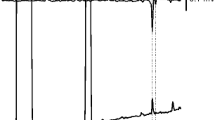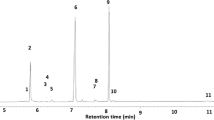Abstract
A multicomponent sex pheromone inMacrocentms grandii Goidanich (Hymenoptera: Braconidae) was demonstrated using wind-tunnel and field bioassays. In wind-tunnel bioassays, three Florisii fractions from female wasps (hexane, 5%, and 50% ether in hexane) and one from male wasps (50% ether in hexane) were attractive to males. The hexane and 5% ether in hexane fractions each elicited similar male behavioral responses. These included upwind anemotaxis, casting, landing on the source, wing fanning, and mating attempts between males. The 50% ether in hexane fraction, whether male- or female-derived, initiated a strong flight response by males but few landings on the source. In addition, the 50% ether in hexane fraction was found to synergize strongly the hexane fraction. All females tested in the wind tunnel gave no responses to male- or female-derived extracts. Field tests generally supported the wind-tunnel results, although no field attraction was observed for the 5% ether in hexane fraction.
Similar content being viewed by others
References
Andreadis, T.G. 1980.Nosema pyrausta infection ofMacrocentrus grandii-a braconid parasite of the European corn borer,Ostrinia nubilalis.J. Invert. Pathol. 5:229–233.
Andreadis, T.G. 1982. Current status of native parasites of the European corn borer in Connecticut.J. Econ. Entomol. 75:626–629.
Assem, J. van den, Jachmann, F. andDe Jong, A.G. 1981. Courtship behavior ofNasonia vitripennis: Head nodding, mouth-part extrusion and pheromone discharge by abdomectomized males.Entomol. Exp. Appl. 30:215–218
Burbutis, P.P., Erwin, N., andErtle, L.R. 1981. Reintroduction and establishment ofLydella thompsoni and notes of other parasites of the European corn borer in Delaware.Environ. Entomol. 10:779–781.
Chiang, H.C. 1978. Pest management in corn.Annu. Rev. Entomol. 23:101–123.
Chiang, H.C., andPalmer, D.F. 1978. Attempts to enrich the parasite fauna of the European corn borer in Minnesota.J. Minn. Acad. Sci. 44:15–16.
Ding, D., Swedenborg, P.D., andJones, R.L. 1989. Chemical stimuli in host-seeking behavior ofMacrocentrus grandii (Hymenoptera: Braconidae).Ann. Entomol. Soc. Am. 82:232–236.
Eller, F.J., Bartelt, R.J., Jones, R.L., andKulman, H.M. 1984. Ethyl (Z)-9-hexadecenoate a sex pheromone ofSyndipnus rubiginosus, a sawfly parasitoid.J. Chem. Ecol. 10:291–300.
Gonzalez, J.M., Matthews, R.W., andMatthews, J.R. 1985. A sex pheromone in males ofMelittobia australica andM. femorata (Hymenoptera: Eulophidae).Fla. Entomol. 68:279–286.
Greany, P.D., Vinson, S.B., andLewis, W.J. 1984. Insect parasitoids: Finding new opportunities for biological control.BioScience 34:690–696.
Guthrie, W.D., Russell, W.A., andJennings, C.W. 1971 Resistance of maize to second-brood European corn borer, pp. 165–179, in J.I. Sutherland and R.J. Falasca (eds.). Report of Twenty-sixth Annual Corn and Sorghum Research Conference, Chicago, Illinois, December 14–16. American Seed Trade Association, Washington, D.C.
Jones, R.L. 1989. Semiochemicals mediatingMicroplitis croceipes habitat, host, and mate finding behavior.Southwest. Entomol. 12:53–57.
Lewis, L.C. 1982. Present status of introduced parasitoids of the European corn borer,Ostrinia nubilalis (Hübner) in Iowa.Iowa State J. Res. 56:429–436
Lewis, W.J., Snow, J.W., andJones, R.L. 1971. A pheromone trap for studying populations ofCardiochiles nigriceps, a parasite ofHeliothis virescens.J. Econ. Entomol. 64:1417–1421.
Morse, B.W., andKulman, H.M. 1985. Monitoring damage by yellowheaded spruce sawflies with sawfly and parasitoid pheromones.Environ. Entomol. 14:131–133.
Pintureau, B., andToonders, T. 1983. Some results concerning the study of attraction of males by females ofTrichogmmma maidis (Hymenoptera: Trichogrammatidae) (in French).Bull. Soc. Linn. Lyon 52:81–87.
Powell, J.E., andKing, E.G. 1984. Behavior of adultMicroplitis croceipes (Hymenoptera: Braconidae) and parasitism ofHeliothis spp. (Lepidoptera: Noctuidae) host larvae in cotton.Environ. Entomol. 13:272–277.
Powell, W. andZhang, Z. 1983. The reactions of two cereal aphid parasitoids,Aphidius uzbekistanicus andA. ervi to host aphids and their food-plants.Physiol. Entomol. 9:439–443.
Qui, H., Ding, D., andQui, Z. 1984. Observations on the mating behavior ofTetrastichus schoenobii Fernere.Contrib. Shanghai Inst. Entomol. 4:77–84.
Robacker, D.C., Weaver, K.M., andHendry, L.B. 1976. Sexual communication and associative learning in the parasitic waspItoplectis conquisitor (Say).J. Chem. Ecol. 2:39–48.
Rotheray, C.E. 1981. Courtship, male swarms and a sex pheromone ofDiplazon pectoratorius (Thunberg) (Hymenoptera: Ichneumonidae).Entomol. Gaz. 32:193–196.
Singh, R. andSinha, T.B. 1982. Bionomics ofTrioxys (Binodoxys) indicns Subba Rao and Sharma, an aphidiid parasitoid ofAphis craccivora Koch. XII. Courtship and mating behavior.Entomon 7:303–309.
Steel, R.G.D., andTorrie, J.H. 1980. Principles and Procedures of Statistics. McGraw-Hill, New York, 633 pp.
Tagawa, J. 1983. Female sex pheromone glands in the parasitic wasps, genusApanteles.Appl. Entomol. Zool. 18:416–427.
Tagawa, J. andKitano, H. 1981. Mating behaviour of the braconid wasp,Apanteles glomeratus L. (Hymenoptera: Braconidae) in the field.Appl. Entomol. Zool. 16:345–350.
Takahashi, S., andSugai, T. 1982. Mating behavior of the parasitoid waspTetrastichus hagenowii (Hymenoptera: Eulophidae).Entomol. Gen. 7:287–293.
Tumlinson, J.H. 1988. Contemporary frontiers in insect semiochemical research.J. Chem Ecol. 1:2109–2131.
Vinson, S.B. 1978. Courtship behavior and source of a sexual pheromone fromCardiochiles nigriceps.Ann. Entomol. Soc. Amr. 71:832–837.
Weseloh, R. 1977. Mating behavior of the gypsy moth parasite,Apanteles melanoscelus.Ann. Entomol. Soc. Amr. 70:549–554.
Weseloh, R. 1980. Sex pheromone gland of the gypsy moth parasitoid,Apanteles melanoscelus: Revaluation and ultrastructural survey.Ann. Entomol. Soc. Amr. 73:576–580.
Winnie, W.V., andChiang, H.C. 1984. Seasonal history ofMacrocentrus grandii (Hym.: Braconidae) andEriborus terebrans (Hym.: Ichneumonidae), two parasitoids of the European corn borer.Ostrinia nubilalis (Lep.: Pyralidae).Entomophaga 27:183–188.
Author information
Authors and Affiliations
Rights and permissions
About this article
Cite this article
Swedenborg, P.D., Jones, R.L. Multicomponent sex pheromone inMacrocentrus grandii Goidanich (Hymenoptera: Braconidae). J Chem Ecol 18, 1901–1912 (1992). https://doi.org/10.1007/BF00981915
Received:
Accepted:
Issue Date:
DOI: https://doi.org/10.1007/BF00981915




